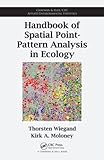Handbook of spatial point-pattern analysis in ecology / Thorsen Wiegand, Kirk A. Moloney
Por: Wiegand, Thorsen [autor/a].
Moloney, Kirk Adams [autor/a].
Tipo de material: Libro
impreso(a)
Series Editor: Boca Raton, FL: Chapman and Hall/CRC, 2014Descripción: xxvii, 510 páginas : ilustraciones, mapas ; 24 centímetros.ISBN: 142008254X; 9781420082548.Tema(s): Ecología
Libro
impreso(a)
Series Editor: Boca Raton, FL: Chapman and Hall/CRC, 2014Descripción: xxvii, 510 páginas : ilustraciones, mapas ; 24 centímetros.ISBN: 142008254X; 9781420082548.Tema(s): Ecología| Tipo de ítem | Biblioteca actual | Colección | Signatura | Estado | Fecha de vencimiento | Código de barras |
|---|---|---|---|---|---|---|
| Libros |
Biblioteca San Cristóbal
Texto en la configuración de la biblioteca San Cristóbal |
Acervo General | 577.015195 W5 | Disponible | ECO010017632 |
Incluye bibliografía: páginas 481-495 e índice: páginas 497-510
Glosario: páginas 467-479
Preface.. Acknowledgments.. Authors.. 1. Application of Spatial Statistics in Ecology.. 1.1 Analysis of Spatial Patterns.. 2. Fundamentals of Point-Pattern Analysis.. 2.1 Fundamental Steps of Point-Pattern Analyses.. 2.2 Data Types.. 2.3 Summary Statistics.. 2.4 Null Models and Point-Process Models.. 2.5 Methods to Compare Data and Point-Process Models.. 2.6 Dealing with Heterogeneous Patterns.. 3. Estimators and Toolbox.. 3.1 Estimators of Summary Statistics.. 3.2 Replicate Patterns.. 3.3 Superposition of Point Processes.. 3.4 Toolbox.. 4. Examples.. 4.1 Analysis of Univariate Patterns.. 4.2 Analysis of Bivariate Patterns.. 4.3 Analysis of Multivariate Patterns.. 4.4 Analysis of Qualitatively Marked Patterns.. 4.5 Analysis of Quantitatively Marked Patterns.. 4.6 Analysis of Objects with Finite Size.. 5. A Course Outline Based on the Book.. 5.1 Introduction.. 5.2 Analysis of Univariate Patterns.. 5.3 Analysis of Bivariate Patterns.. 5.4 Analysis of Qualitatively Marked Patterns.. 5.5 Analysis of Quantitatively Marked Patterns.. 5.6 Analysis of Objects of Finite Size and Real Shape.. Frequently Used Symbols.. Glossary.. References.. Index
Although numerous statistical methods for analyzing spatial point patterns have been available for several decades, they haven't been extensively applied in an ecological context. Addressing this gap, Handbook of Spatial Point-Pattern Analysis in Ecology shows how the techniques of point-pattern analysis are useful for tackling ecological problems. Within an ecological framework, the book guides readers through a variety of methods for different data types and aids in the interpretation of the results obtained by point-pattern analysis. Ideal for empirical ecologists who want to avoid advanced theoretical literature, the book covers statistical techniques for analyzing and interpreting the information contained in ecological patterns. It presents methods used to extract information hidden in spatial point-pattern data that may point to the underlying processes. The authors focus on point processes and null models that have proven their immediate utility for broad ecological applications, such as cluster processes. Along with the techniques, the handbook provides a comprehensive selection of real-world examples. Most of the examples are analyzed using Programita, a continuously updated software package based on the authors' many years of teaching and collaborative research in ecological point-pattern analysis. Programita is tailored to meet the needs of real-world applications in ecology. The software and a manual are available online. eng
